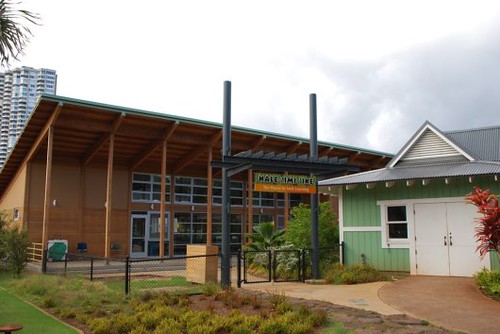Hale Imi Iki Learning Center takes zoological education into the 21st century
HONOLULU—In March of 2009, the Honolulu Zoo quietly opened its Hale Imi Iki Learning Center, a state of the art teaching environment that stands adjacent to the Keiki Zoo and is designed to complement the zoo’s hands-on educational offerings. Already having proved to be a great asset to the zoo, it is surprisingly unknown to the public.
The 2,800-square-foot sustainable building was designed by Urban Works, a local architecture, interiors, and planning firm that is also responsible for the new entrance facilities to the zoo, set to open this November. In fact, the architecture of the two areas will reference each other aesthetically, and will work in tandem to make the zoo’s offerings more accessible to the public.
According to Malia Goldberg, Project Designer at Urban Works, the schematic designs (i.e. general view of a building’s components and scale based on detailed discussions of client’s vision) of the two buildings occurred roughly at the same time—though the Zoo Entry is even more ambitious in terms of both concept and construction and many of its details were worked out after the Learning Center construction was complete.
Hale Imi Iki means “house of seeking knowledge,” an appropriate name for this multipurpose educational space. Leading up to the building are footprints of various zoo animals—tigers, elephants, chimpanzees, and so forth—that strongly yet playfully announces the building’s intention. There is also a large selection of Native Hawaiian plants that make up the landscaping, such as the beautiful ohai from Kaena Point, with its hairy silvery leaves and oddly-shaped orange flowers.

The Honolulu Chapter of the Construction Specifications Institute (CSI) offered a site tour of the Hale Imi Iki on August 17. There, lead architect John Ida emphasized the importance of considering natural elements in the building’s design. The steeply angled roof and large overhang are oriented to optimize daylight while reducing the impact of harsh sunlight, even in the late afternoon. Studies have shown that exposure to sunlight has a positive effect on one’s mood. To this end, solar tubes resembling light fixtures allow this natural light to remain into the evening.
The building also boasts flat photovoltaic panels, generating power that goes right back into the grid, thereby offsetting the usage of the building. The building’s many windows are all operable and are usually open, maximizing on the good natural ventilation offered by our trade winds.
The primary material selected for the building was cedar, which is sustainable, economical, and offers good acoustics. The rafters were deliberately left exposed, creating a lattice effect and a certain integrity that comes from revealing the “bones” of the structure.
This “form follows function” aesthetic carries into the interior. The flooring consists of polished concrete made more comfortable with the addition of modular carpet squares. The floor is also completely hooked up for technology, allowing for various configurations depending on the desired use.
Besides functioning as a classroom for school groups and zoo programs for children, the Learning Center is also a state of the art venue for multi-media presentations, making it a locus of adult activities such as volunteer orientations, member events, evening lecture series, and zoo staff meetings and training sessions.
There is also a generous amount of work stations, storage, and seating for up to 50 people in the main room. Restrooms and a cozy reading nook adorned with various animal artifacts round out the spacious floor plan. The overall look is clean and modern, yet warm and welcoming.
Given the thought and attention given to sustainable and practical design, one may wonder why it did not achieve Leadership in Energy & Environmental Design (LEED) status. LEED is an internationally recognized green building certification system, providing third-party verification that a building (or community) was designed and built in a way that improves performance in areas such as energy savings, water efficiency, CO2 emissions reduction, improved indoor environmental quality, and management of resources and sensitivity to their impacts.
According to Goldberg, the Learning Center does incorporate many design strategies that would collect points in the LEED certification process. However, she states that Urban Works’ strategy was “to design a building that incorporates sustainable systems and building materials in an integrative manner, rather than sticking strictly to the LEED checklist.”
LEED certification also tends to add a great deal of cost, both from a construction side and an administrative standpoint. So, while the building lacks an official LEED status, it does display a significant level of environmental stewardship, which, as Goldberg points out, also translates to long term cost savings for the City.
For more information about Urban Works, visit http://www.uwarchitects.com.
To learn about CSI, check out their website: http://www.csihonolulu.org.
For descriptions of the variety of educational programs offered by the zoo, such as Vacation Adventure camps, Dinner Safaris, Snooze in the Zoo, and more, please visit http://www.honzoosoc.org.